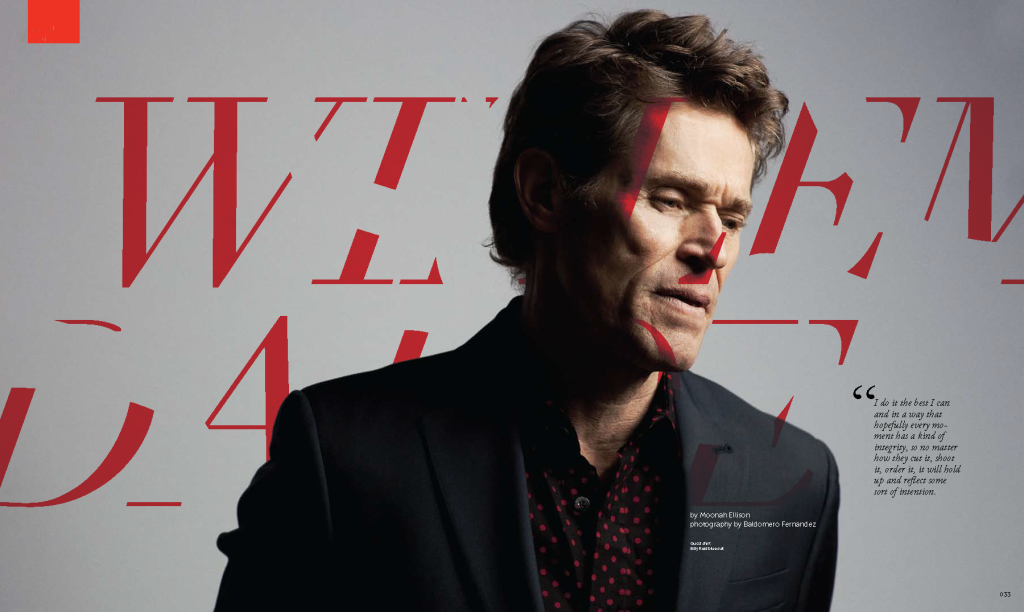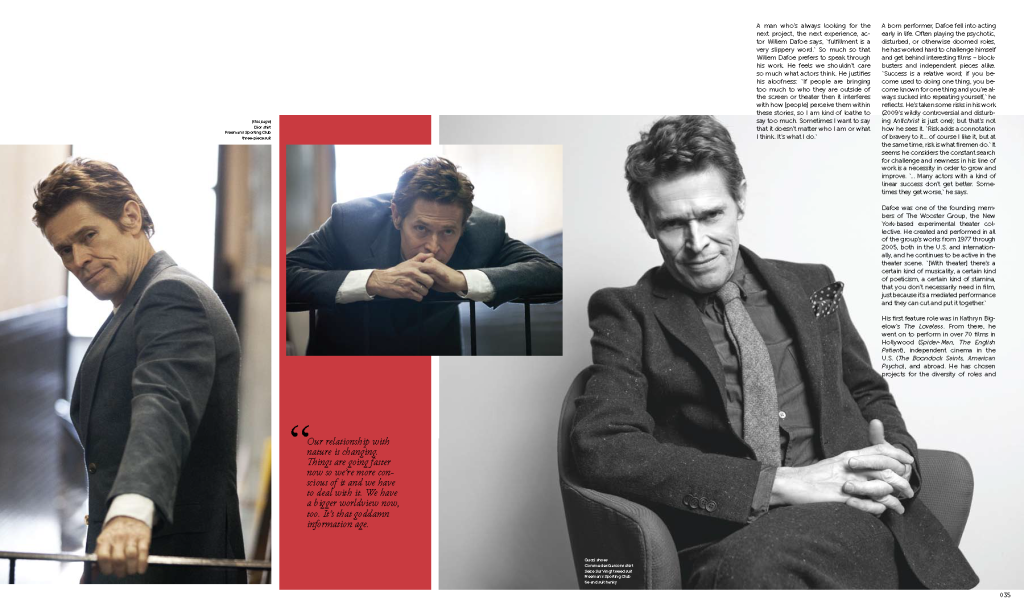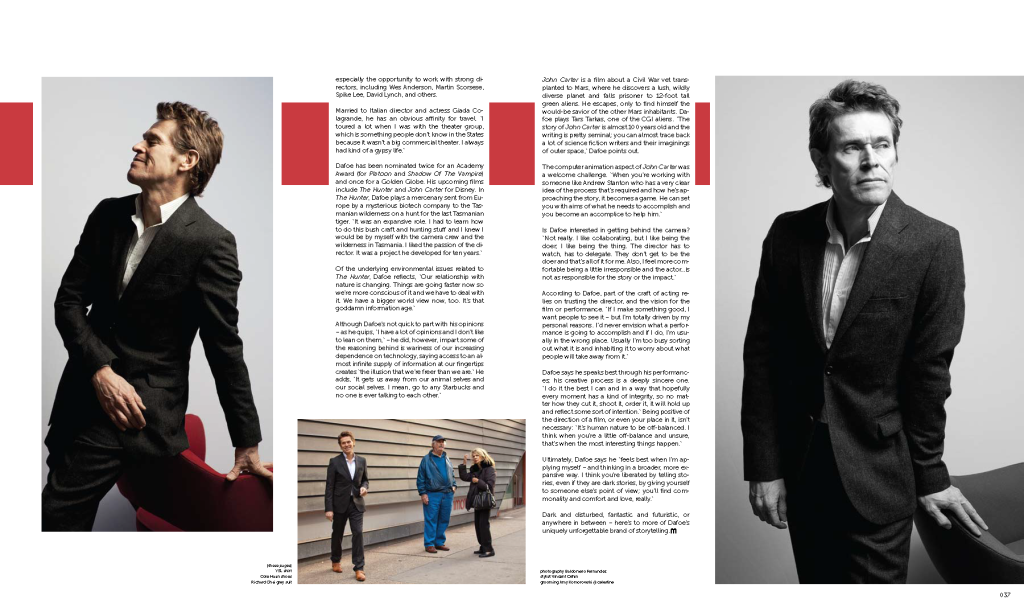

I do it the best I can and in a way that hopefully every moment has a kind of integrity, so no matter how they cut it, shoot it, order it, it will hold up and reflect some sort of intention.
by Moonah Ellison
photography by Baldomero Fernandez
A man who’s always looking for the next project, the next experience, actor Willem Dafoe says, “fulfillment is a very slippery word.” So much so that Willem Dafoe prefers to speak through his work. He feels we shouldn’t care so much what actors think. He justifies his aloofness: “If people are bringing too much to who they are outside of the screen or theater then it interferes with how [people] perceive them within these stories, so I am kind of loathe to say too much. Sometimes I want to say that it doesn’t matter who I am or what I think. It’s what I do.”
A born performer, Dafoe fell into acting early in life. Often playing the psychotic, disturbed, or otherwise doomed roles, he has worked hard to challenge himself and get behind interesting films – blockbusters and independent pieces alike. “Success is a relative word; if you become used to doing one thing, you become known for one thing and you’re always sucked into repeating yourself,” he reflects. He’s taken some risks in his work (2009’s wildly controversial and disturbing Antichrist is just one); but that’s not how he sees it. “Risk adds a connotation of bravery to it… of course I like it, but at the same time, risk is what firemen do.” It seems he considers the constant search for challenge and newness in his line of work is a necessity in order to grow and improve. “… Many actors with a kind of linear success don’t get better. Sometimes they get worse,” he says.
Our relationship with nature is changing. Things are going faster now so we’re more conscious of it and we have to deal with it. We have a bigger worldview now, too. It’s that goddamn information age.
Dafoe was one of the founding members of The Wooster Group, the New York-based experimental theater collective. He created and performed in all of the group’s works from 1977 through 2005, both in the U.S. and internationally, and he continues to be active in the theater scene. “[With theater] there’s a certain kind of musicality, a certain kind of poeticism, a certain kind of stamina, that you don’t necessarily need in film, just because it’s a mediated performance and they can cut and put it together.”
His first feature role was in Kathryn Bigelow’s The Loveless. From there, he went on to perform in over 70 films in Hollywood (Spider-Man, The English Patient), independent cinema in the U.S. (The Boondock Saints, American Psycho), and abroad. He has chosen projects for the diversity of roles and especially the opportunity to work with strong directors, including Wes Anderson, Martin Scorsese, Spike Lee, David Lynch, and others.
Married to Italian director and actress Giada Colagrande, he has an obvious affinity for travel. “I toured a lot when I was with the theater group, which is something people don’t know in the States because it wasn’t a big commercial theater. I always had kind of a gypsy life.”

Dafoe has been nominated twice for an Academy Award (for Platoon and Shadow Of The Vampire) and once for a Golden Globe. His upcoming films include The Hunter and John Carter for Disney. In The Hunter, Dafoe plays a mercenary sent from Europe by a mysterious biotech company to the Tasmanian wilderness on a hunt for the last Tasmanian tiger. “It was an expansive role. I had to learn how to do this bush craft and hunting stuff and I knew I would be by myself with the camera crew and the wilderness in Tasmania. I liked the passion of the director. It was a project he developed for ten years.”
Of the underlying environmental issues related to The Hunter, Dafoe reflects, “Our relationship with nature is changing. Things are going faster now so we’re more conscious of it and we have to deal with it. We have a bigger world view now, too. It’s that goddamn information age.”
Although Dafoe’s not quick to part with his opinions – as he quips, “I have a lot of opinions and I don’t like to lean on them,” – he did, however, impart some of the reasoning behind is wariness of our increasing dependence on technology, saying access to an almost infinite supply of information at our fingertips creates “the illusion that we’re freer than we are.” He adds, “It gets us away from our animal selves and our social selves. I mean, go to any Starbucks and no one is ever talking to each other.”
John Carter is a film about a Civil War vet transplanted to Mars, where he discovers a lush, wildly diverse planet and falls prisoner to 12-foot tall green aliens. He escapes, only to find himself the would-be savior of the other Mars inhabitants. Dafoe plays Tars Tarkas, one of the CGI aliens. “The story of John Carter is almost 100 years old and the writing is pretty seminal; you can almost trace back a lot of science fiction writers and their imaginings of outer space,” Dafoe points out.
The computer animation aspect of John Carter was a welcome challenge. “When you’re working with someone like Andrew Stanton who has a very clear idea of the process that’s required and how he’s approaching the story, it becomes a game. He can set you with aims of what he needs to accomplish and you become an accomplice to help him.”

Is Dafoe interested in getting behind the camera? “Not really. I like collaborating, but I like being the doer; I like being the thing. The director has to watch, has to delegate. They don’t get to be the doer and that’s all of it for me. Also, I feel more comfortable being a little irresponsible and the actor…is not as responsible for the story or the impact.”
According to Dafoe, part of the craft of acting relies on trusting the director, and the vision for the film or performance. “If I make something good, I want people to see it – but I’m totally driven by my personal reasons. I’d never envision what a performance is going to accomplish and if I do, I’m usually in the wrong place. Usually I’m too busy sorting out what it is and inhabiting it to worry about what people will take away from it.”
Dafoe says he speaks best through his performances; his creative process is a deeply sincere one. “I do it the best I can and in a way that hopefully every moment has a kind of integrity, so no matter how they cut it, shoot it, order it, it will hold up and reflect some sort of intention.” Being positive of the direction of a film, or even your place in it, isn’t necessary: “It’s human nature to be off-balanced. I think when you’re a little off-balance and unsure, that’s when the most interesting things happen.”
Ultimately, Dafoe says he “feels best when I’m applying myself – and thinking in a broader, more expansive way. I think you’re liberated by telling stories, even if they are dark stories, by giving yourself to someone else’s point of view; you’ll find commonality and comfort and love, really.”
Dark and disturbed, fantastic and futuristic, or anywhere in between – here’s to more of Dafoe’s uniquely unforgettable brand of storytelling.


